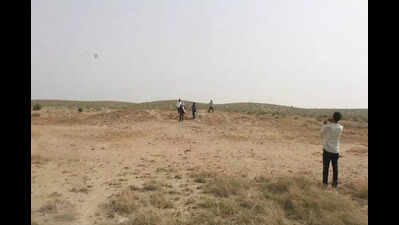Thar yields Harappan site, shifting Indus Valley map | Jaipur News

JAISALMER: Red shards glinting in desert sand. A kiln with a central column, long buried. Chert blades and terracotta cakes from a civilisation 4,500 years old. History has stirred beneath the dunes of Thar’s scorching crust.A Harappan site has surfaced at Ratadiya Ri Dheri in Jaisalmer district, marking the first known Indus Valley settlement in Rajasthan’s arid region. Located 60km from Ramgarh tehsil and just 17km northwest of Pakistan’s Sadewala — where Harappan traces were earlier found — this find bridges a vital archaeological gap between northern Rajasthan and Gujarat.Until now, Pilibanga in northern Rajasthan was the state’s most prominent Harappan site — discovered by Italian Indologist Luigi Pio Tessitori in the early 20th century and excavated in the 1960s. Ratadiya Ri Dheri pushes the frontier southward into the heart of India’s desert.History lecturer Dilip Kumar Saini and local enthusiast Parth Jagani discovered the site recently. Their discovery has since been validated by experts from University of Rajasthan and Rajasthan Vidyapeeth in Udaipur.Saini reported an abundance of red pottery — bowls, pots, perforated jar fragments — alongside clay and shell bangles, terracotta objects, and stone tools. Wedge-shaped bricks used in circular kilns and walls, a kiln design found at Kanmer in Gujarat and Mohenjo-daro in Pakistan, suggest a complex settlement.Archaeologists date the settlement to the mature urban phase of the Indus Valley civilisation — 2600 to 1900 BCE. “It is a small rural Harappan settlement,” said Jeevan Singh Kharkwal, professor at Rajasthan Vidyapeeth. “Identified through terracotta cakes, Harappan pottery, stone tools, and Rohri chert blade fragments, it is an extension of the Sindh Harappan network.”Dr Tamegh Panwar from University of Rajasthan’s history and Indian culture department called the find “very significant,” saying: “The site reflects a vibrant hinterland trade mechanism.” Artefacts such as blades made of chert — a sedimentary rock sourced from Rohri in Pakistan — point to long-distance exchange and resource integration, typical of Indus Valley urban centres.A research paper detailing the findings, co-authored by Saini and others, has been submitted to Indian Science Journal for peer-reviewed publication.





